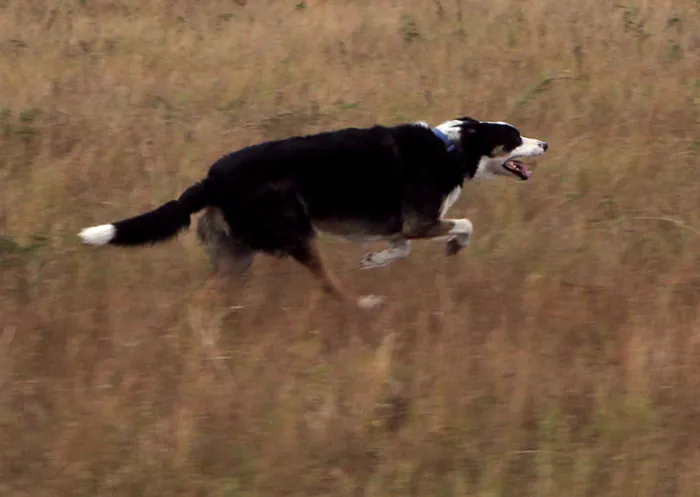New KZN airport not hard to swallow

Don, a 10 year old Border Collie, is one of three dogs that poses a threat to birds and other wildlife at the King Shaka International Airport. He has clocked speeds of 55km/h while doing the job he loves. PICTURE: S'BONELO NGCOBO Don, a 10 year old Border Collie, is one of three dogs that poses a threat to birds and other wildlife at the King Shaka International Airport. He has clocked speeds of 55km/h while doing the job he loves. PICTURE: S'BONELO NGCOBO
From mid-October bird enthusiasts notice the growing migration of swallows that trek more than 16 000km from Europe to roost at the Mount Moreland reed bed.
By November the number increases to millions, and a swirling solid mass can be seen making its way to a site a few kilometres away from King Shaka International Airport.
But the swallows, which have been trekking to Durban since the early 1970s, have a new challenge to contend with – air traffic going in and out of the airport right over their roosting spot.
So serious was the danger of their getting sucked into the engines that there was talk that either the airport project would be shelved or the roosting site had to be destroyed – both of which have been avoided, thanks to a hi-tech radar system and three Border collies.
The birds stay until April, leaving the reed bed, where they roost overnight, every morning and returning a few minutes before sunset after feeding on insects.
Their return is a spectacular sight as the mass hovers over the reed bed before suddenly dropping to nest on the leaves of the lush reed bed overnight in under a minute.
However, the big birds (planes) and the small birds (barn swallows) have been coexisting peacefully thanks to the radar system monitoring the swallows’ movements.
The DeTect Merlin Bird Detection Radar system, costing about R3.5 million, is the first of its kind to be used at a commercial airport in South Africa.
The radar system keeps tabs on the birds’ flight patterns, which are passed on to the control tower, which can then relay the information to pilots.
The radar system was custom-built by an American company and is situated at the end of the runway and covers a radius of 3.7km, showing clearly when there is a build-up in bird density.
Meanwhile, a few kilometres away at the airport, Mac, Tweeny and Don – three Border collies that worked at the old airport – are doing their bit to keep birds and other wildlife such as mongooses, rabbits and monkeys off the airport runways.
Their trainer, Marius van Rooyen, said the dogs were specially trained to pose as a threat to the birds, but never harm them. “The dogs undergo an intense one and a half years’ training and are able to work for over 10 years.”
The programme, which started in 2002, was a first in the country, and has since been implemented at other airports nationally, and has garnered international interest.
Sadly, Mac and Tweeny, both aged 10, will retire at the end of the year and will be replaced by a newly trained dog.
The dogs are kept in large kennels in an enclosed area near the runway and are kept active performing their duties between 6am and 9am, which is peak time for the birds to feed on insects on the lush grass alongside the runway.
“When they aren’t working, they are playing…
“We keep them fit and Don has clocked speeds of 55km/h.
“My dogs are very good. There would be major birdstrikes if there were no dogs,” he said proudly.
Angie Wilken, spokeswoman for the Lake Victoria Conservancy at Mount Moreland, said the swallows had unexpectedly chosen Froggy Pond to roost – the first time they had done this. However, it was still in the same area as their prior roosting spot just 4km away.
“We don’t know why they are doing this and people are blaming the new airport for the move. However the swallows have moved closer to the airport, so it is not to blame,” she said.
She has been actively following the barn swallows’ patterns for the past 17 years, and has kept a daily log on a website of any changes in their patterns for the past five years.
“The barn swallows come to South African for the warm weather and the food source, feeding on local insects.
“They don’t breed here or build nests – they come with their young and teach them the ways of the world.”
She said the airport and the swallows were coexisting, with the radar system playing a good monitoring role.
Wilken said it was discovered this year that the birds sat on the leaf of the reed. It was previously thought they clutched the stalk overnight.
“Nature is a wonderful thing as you are constantly learning.”
Airports Company South Africa spokesman Colin Naidoo said they were striving to ensure a peaceful coexistence.
“This is the first season that the swallows have arrived with the airport being operational and there have been no major snags.
“It is amazing how the birds and planes can coexist. The highest level the bird flies is the lowest that a plane flies, so we have avoided any collisions.”
For more information visit www.barnswallow.co.za.
[email protected] - Sunday Tribune